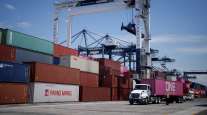Senior Reporter
Ports Report Mixed Results in November

[Stay on top of transportation news: Get TTNews in your inbox.]
An economy that is returning to more balanced spending between goods and services was reflected in mixed November results across the nation’s ports, as container volumes stabilized even as shippers moved goods in anticipation of a busy holiday shopping season.
Amid these shifts, many facilities are investing in upgrades for the future.
The Port of Los Angeles saw container volume rise nearly 19.4% as it processed 763,261 20-foot-equivalent containers, or TEUs, during November, compared with 639,343 a year ago. “Our year-end growth reflects the strength of the U.S. economy powered by the American consumer,” Port of Los Angeles Executive Director Gene Seroka said at a media briefing.
The nearby Port of Long Beach reported a 24.2% year-over-year increase, processing 731,033 containers in November compared with 588,742 a year ago.

The Port of Seattle received two all-electric Super Post Panamax cranes. (Northwest Seaport Alliance)
A post-holiday shopping report from Mastercard showed year-over-year retail sales rose 3.1% between Nov. 1 and Dec. 24 as shoppers looked for last-minute deals amid big promotions. While the number is up, it was fractionally below forecasts and less than half of the increase from the previous year as higher credit card interest rates and inflationary pressures remain.
Despite the gains at L.A. and Long Beach, other West Coast ports saw declines.
The Port of Oakland reported a 4.4% year-over-year decline in November container volume, processing 176,379 TEUs compared with 184,606 a year ago. And the Northwest Seaport Alliance, which operates the twin ports at Seattle and Tacoma, reported a 6.6% annual decline for the month, processing 230,787 containers compared with 247,037 a year ago.
During the month, the Port of Seattle took delivery of two all-electric Super Post-Panamax cranes and three hybrid rubber tire gantry cranes. The Super Post-Panamax cranes, which are 316 feet tall and have a 240-foot outreach boom, joined the four existing cranes in operation. The new cranes are among the largest on the Pacific Coast, clearing the way for Seattle to handle the largest ships in the world.
Other facilities are likewise investing in expansion.
Officials at the Port of Long Beach announced the facility has been selected to receive $283 million in federal funding to assist in expanding rail capacity. The effort will more than triple the amount of cargo that can be loaded, unloaded and moved by rail at the facility. Construction is set to begin in 2024 and scheduled for completion by 2032.
ICYMI: Cargo ⬆️ at the #PortofLA
For the fourth consecutive month, Port of Los Angeles cargo volume increased -- with 763,262 Twenty-Foot Equivalent Units (TEUs) processed in November, a 19% improvement compared to last year. https://t.co/k3eZABNVtk pic.twitter.com/IkTj5UiqNe — Port of Los Angeles (@PortofLA) December 16, 2023
Meanwhile, Port Houston is in the midst of a billion-dollar-plus expansion that includes widening and deepening the Houston Ship Channel. The effort is intended to increase safety, reduce congestion and reduce vessel transit times. It’s set for completion in 2025.
“As we continue to expand the Houston Ship Channel, we will be able to accommodate larger vessels in the very near future. We are also adding wharf and yard capacity at our container terminals, so we are well-equipped to continue to help drive the growth of our entire region,” Port Executive Director Roger Guenther said.
During November, the facility saw a 15% year-over-year decline in TEU volume, processing 297,622 containers, compared with 366,208 a year ago. Year-to-date, the facility is down 5% from 2022’s record-setting pace.
The Port of Savannah said it saw cargo decline by 10.2% year-over-year, processing 417,145 TEUs in November compared with 464,883 a year ago. But as with Houston and other ports, massive expansion plans are underway. During the annual Georgia Transportation Summit, port leaders on Dec. 15 detailed the port authority’s ambitious $4.5 billion spending package to nearly double capacity by 2035.
Want more news? Listen to today's daily briefing above or go here for more info
The Port of Virginia also posted a November decline, as TEU volume fell 9.9% to 276,005 containers compared with 306,575 a year ago. Against the backdrop of this decline, the facility received a mixed bag of news about its efforts to begin generating electricity from offshore wind turbines near the complex. While the U.S. Department of Transportation has awarded $39.2 million to the port to convert an existing marine terminal and berth to an offshore wind logistics facility, renewable energy manufacturer Siemens Gamesa canceled a proposed $200 million factory to become a hub for offshore wind projects for the port.
South Carolina’s Port of Charleston said it saw November cargo volume decline 5.5% to 201,314 TEUs compared with 213,073 a year ago. The port is in the middle of a $50 million expansion, creating an off-site container location linked by rail near the Greenville-Spartanburg International Airport. There, cargo will be staged before being moved by truck and rail.
The Port Authority of New York/New Jersey, the busiest complex on the Atlantic coast, is always one month behind the other ports reporting container volume. In October, the facility was down 6.3% year-over-year, processing 742,571 containers compared with 792,598 the previous year.




